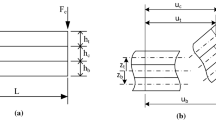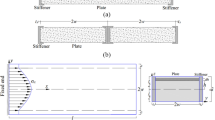Abstract
This paper presents a 2-Dimensional mathematical model which only considers the length and thickness of the cantilever beams and omits the width to analyze the vibrational behavior of the step-up supported cantilever beams. This model accounts for the step-up boundary condition by replacing it with a simply-supported boundary condition in conjunction with equivalent torsional stiffness, which is more accurate boundary condition compared with a clamped boundary condition. In this paper, the mathematical model is compared with the finite element simulation, and the effect of the thickness t m of the support beam and the Young’s modulus E on the resonant frequencies is analyzed. The comparison shows that the differences between the model prediction and simulated results are <2 % for the case of the t m = 2 μm and E = 79.42 GPa at the length of 50–380 μm. In addition, with decreasing the E or t m , the resonant frequency of the cantilever beam will decrease. Furthermore, the measurement of the resonant frequencies demonstrates the validity of this model, with small errors.










Similar content being viewed by others
References
Baek CW, Kim YK, Ahn Y, Kim YH (2005) Measurement of the mechanical properties of electroplated gold thin films using micromachined beam structures. Sens Actuators A 117:17–27
Cui Y, Liao X (2012) Modeling and design of a capacitive microwave power sensor for X-band applications based on GaAs technology. J Micromech Microeng 22:055013
Cui Y, Liao X, Zhu Z (2011) A novel microwave power sensor using MEMS fixed-fixed beam. In: IEEE sensors, limerick, Oct 2011, pp 1305–1308
Fricke J, Obermeier E (1993) Cantilever beam beam accelerometer based on surface micromachining technology. J Micromech Microeng 3:190
Gill JY, Ngo LV, Nelson PR, Kim JY (1998) Elimination of extra spring effect at the step-up anchor of surface-micromachined structure. J Microelectromech Syst 7:114–121
Gupta RK (2000) Electronically probed measurements of MEMS geometries. J Microelectromech Syst 9:380–389
Karnovsky IA, Lebed OI (2004) Free vibrations of beams and frames. McGraw-Hill, New York, pp 43–74
Leissa AW, Qatu MS (2011) Vibrations of continuous systems. McGraw-Hill, New York, pp 103–265
Li F, Peroulis D, Clark JV (2014) Measuring effective flexure width by measuring comb drive capacitance. J Microelectromech Syst 23:972–979
Meng Q, Mehregany M, Mullen RL (1993) Theoretical modeling of microfabricated beams with elastically restrained supports. J Microelectromech Syst 2:128–137
Mullen RL, Mehregany M, Omar M, Ko W (1991) Theoretical modeling of boundary conditions in microfabricated beams. In: Proceedings of IEEE micro electro mechanical systems, conference on micro structures, sensors, actuators, machines and robots, Nara, Japan, 30 Jan–2 Feb 1991
Ozdoganlar OB, Hansche BD, Carne TG (2005) Experimental modal analysis for microsystems. Exp Mech 45(6):498–506
Osterberg PM, Senturia SD (1997) M-TEST: a test chip for MEMS material property measurement using electrostatically actuated test structures. J Microelectromech Syst 6:107–118
Song J, Huang Q-A, Li M, Tang J-Y (2009) Effect of die-bonding process on mems device performance: system-level modeling and experimental verification. J Microelectromech Syst 18:274–286
Tang WC, Nguyen T-CH, Roger TH (1989) Laterally driven polysilicon resonant microstructures. Sens Actuators A 20:25–32
Yang G, Liao X, Zhang Z (2013) Young’s modulus and residual stress of MEMS gold beams based on the GaAs MMIC process. J Micromech Microeng 23:045002
Yi Z, Liao X (2013) A capacitive power sensor based on the MEMS cantilever beam fabricated by GaAs MMIC technology. J Micromech Microeng 23:035001
Zhang Z, Liao X (2012) GaAs MMIC fabrication for the RF MEMS power sensor with both detection and non-detection states. Sens Actuators A 188:29–34
Zhang ZQ, Liao XP, Han L, Cheng YS (2011) A GaAs MMIC-based coupling RF MEMS power sensor with both detection and non-detection states. Sens Actuators A 168:30–38
Acknowledgments
This work is supported by the National Natural Science Foundation of China (NSFC: 60976094, 61076108 and 60676043).
Author information
Authors and Affiliations
Corresponding authors
Rights and permissions
About this article
Cite this article
Wang, K., Liao, X. & Zhang, Z. 2-Dimensional vibration model of MEMS cantilever beams with step-up anchors. Microsyst Technol 22, 893–901 (2016). https://doi.org/10.1007/s00542-015-2559-7
Received:
Accepted:
Published:
Issue Date:
DOI: https://doi.org/10.1007/s00542-015-2559-7




